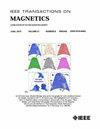晶界扩散对烧结Nd-Fe-B永磁体矫顽力、热稳定性和磁化反转的影响
IF 1.9
3区 工程技术
Q3 ENGINEERING, ELECTRICAL & ELECTRONIC
引用次数: 0
摘要
晶界扩散能显著提高烧结Nd-Fe-B永磁体的矫顽力,优化其组织结构。本文通过粉末冶金法制备了这些磁体,其标称成分为Nd30.25Fe68.22M0.59B0.94 (M代表Cu, Co, Zr, Ga和Al)。在晶界扩散中,氟化铽粉是扩散源。扩散后,磁体的矫顽力大幅度增加。在$25~^{\circ}$ C ~ $150~^{\circ}$ C的温度范围内,矫顽力的温度系数($\beta $)有了显著的提高。矫顽力的显著提高和$\beta $的显著提高是由于在主相晶粒外层形成了具有高磁晶各向异性的富铽(Nd, Tb)2Fe14B相。这优化了晶界结构,减少了晶界扩散过程中主相晶粒的表面缺陷,提高了矫顽力,减弱了交换耦合效应,抑制了磁化反转。反作用回路和热激活反应了这种抑制作用,可能是由于Nd2Fe14B主相晶粒之间或核壳结构的(Nd, Tb)2Fe14B主相晶粒之间以及(Nd, Tb)2Fe14B主相晶粒的核壳之间的交换耦合作用。这些协同作用增强了主相表面反畴的成核场,减小了活化体积。因此,矫顽力增强,有效抑制磁化反转和热波动。这保证了Nd-Fe-B永磁体的高剩磁、热稳定性和抗退磁能力,从而提高了永磁电机长期运行的可靠性和效率。本文章由计算机程序翻译,如有差异,请以英文原文为准。
Influence of Grain Boundary Diffusion on the Coercivity, Thermal Stability, and Magnetization Reversal of Sintered Nd–Fe–B Permanent Magnets
Grain boundary diffusion considerably enhances the coercivity of sintered Nd–Fe–B permanent magnets and optimizes their microstructures. Herein, we fabricated these magnets with a nominal composition of Nd30.25Fe68.22M0.59B0.94 (M represents Cu, Co, Zr, Ga, and Al) via powder metallurgy. Terbium fluoride powder served as the diffusion source in grain boundary diffusion. After the diffusion, the coercivity of the magnets substantially increased. Moreover, the temperature coefficient of coercivity ( $\beta $ ) considerably improved in the temperature range of $25~^{\circ }$ C– $150~^{\circ }$ C. The considerable enhancement in coercivity and its $\beta $ is attributed to the formation of Tb-rich (Nd, Tb)2Fe14B phases with high magnetocrystalline anisotropy in the outer layers of the main phase grains. This optimizes the grain boundary structure and reduces surface defects of the main phase grains during grain boundary diffusion, increasing the coercivity, weakening the exchange coupling effect, and suppressing magnetization reversal. The recoil loops and thermal activation reflect this suppression, possibly owing to the exchange coupling effect among the Nd2Fe14B main phase grains or the (Nd, Tb)2Fe14B main phase grains with a core-shell structure as well as between the core and shell of the (Nd, Tb)2Fe14B main phase grains. These synergistic effects enhance the nucleation field for reverse domains on the main phase surface and reduce the activation volume. Consequently, coercivity is enhanced, effectively suppressing magnetization reversal and thermal fluctuations. This ensures high remanence, thermal stability, and demagnetization resistance in the Nd–Fe–B permanent magnets, thereby enhancing the reliability and efficiency of permanent-magnet motors in long-term operation.
求助全文
通过发布文献求助,成功后即可免费获取论文全文。
去求助
来源期刊

IEEE Transactions on Magnetics
工程技术-工程:电子与电气
CiteScore
4.00
自引率
14.30%
发文量
565
审稿时长
4.1 months
期刊介绍:
Science and technology related to the basic physics and engineering of magnetism, magnetic materials, applied magnetics, magnetic devices, and magnetic data storage. The IEEE Transactions on Magnetics publishes scholarly articles of archival value as well as tutorial expositions and critical reviews of classical subjects and topics of current interest.
 求助内容:
求助内容: 应助结果提醒方式:
应助结果提醒方式:


